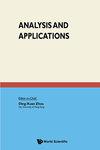混合范数Lebesgue空间经相关Herz空间傅里叶变换的可和性
IF 2.4
2区 数学
Q1 MATHEMATICS
引用次数: 16
摘要
设[公式:见文]、[公式:见文]为混合范数勒贝格空间,[公式:见文]为可积函数。本文通过建立混合中心Hardy-Littlewood极大算子[公式:见文]从[公式:见文]到自身或到弱混合范数Lebesgue空间[公式:见文]的有界性,在[公式:见文]和[公式:见文]的一些尖锐假设下,作者证明了[公式:见文]的[公式:见文]-均值在对角线上几乎处处收敛于[公式:见文],如果[公式:[公式:见文]属于混合范数齐次赫兹空间[公式:见文],[公式:见文]是[公式:见文]的共轭指数。进一步,通过引入另一种混合范数齐次赫兹空间并建立该赫兹空间的表征,作者将上述的[公式:见文]-means的几乎处处收敛推广到无限制情况。最后,作者证明了[公式:见文]的[公式:见文]-均值在其所有[公式:见文]-Lebesgue点上都收敛于[公式:见文]当且仅当[公式:见文]属于[公式:见文],并且对于强[公式:见文]-Lebesgue点上的无限制收敛也有类似的结论成立。观察,在所有这些结果中,[公式:见文本]所属的赫兹空间在某种意义上被证明是最佳选择。本文章由计算机程序翻译,如有差异,请以英文原文为准。
Summability of Fourier transforms on mixed-norm Lebesgue spaces via associated Herz spaces
Let [Formula: see text], [Formula: see text] be the mixed-norm Lebesgue space, and [Formula: see text] an integrable function. In this paper, via establishing the boundedness of the mixed centered Hardy–Littlewood maximal operator [Formula: see text] from [Formula: see text] to itself or to the weak mixed-norm Lebesgue space [Formula: see text] under some sharp assumptions on [Formula: see text] and [Formula: see text], the authors show that the [Formula: see text]-mean of [Formula: see text] converges to [Formula: see text] almost everywhere over the diagonal if the Fourier transform [Formula: see text] of [Formula: see text] belongs to some mixed-norm homogeneous Herz space [Formula: see text] with [Formula: see text] being the conjugate index of [Formula: see text]. Furthermore, by introducing another mixed-norm homogeneous Herz space and establishing a characterization of this Herz space, the authors then extend the above almost everywhere convergence of [Formula: see text]-means to the unrestricted case. Finally, the authors show that the [Formula: see text]-mean of [Formula: see text] converges over the diagonal to [Formula: see text] at all its [Formula: see text]-Lebesgue points if and only if [Formula: see text] belongs to [Formula: see text], and a similar conclusion also holds true for the unrestricted convergence at strong [Formula: see text]-Lebesgue points. Observe that, in all these results, those Herz spaces to which [Formula: see text] belongs prove to be the best choice in some sense.
求助全文
通过发布文献求助,成功后即可免费获取论文全文。
去求助
来源期刊
CiteScore
3.90
自引率
4.50%
发文量
29
审稿时长
>12 weeks
期刊介绍:
Analysis and Applications publishes high quality mathematical papers that treat those parts of analysis which have direct or potential applications to the physical and biological sciences and engineering. Some of the topics from analysis include approximation theory, asymptotic analysis, calculus of variations, integral equations, integral transforms, ordinary and partial differential equations, delay differential equations, and perturbation methods. The primary aim of the journal is to encourage the development of new techniques and results in applied analysis.

 求助内容:
求助内容: 应助结果提醒方式:
应助结果提醒方式:


